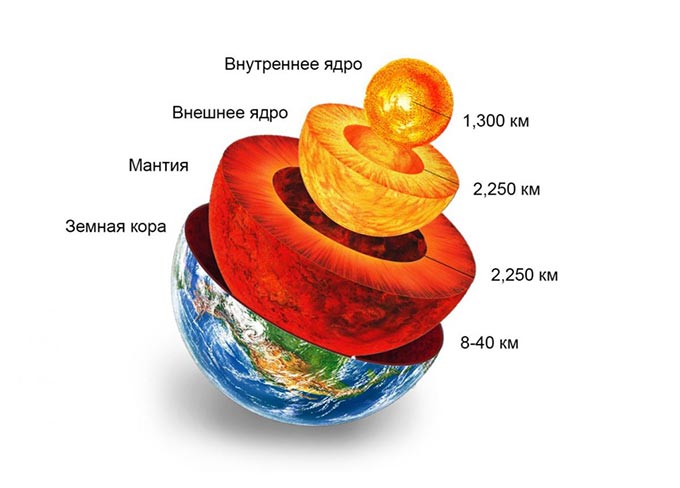Around it, he made the sun, planets and the firmament with fixed stars rotate.
Science has refuted these inventions. Now even preschoolers know that the Earth, like other planets, revolves around the Sun and around its own axis. And yet, it compares favorably with other planets: after all, higher forms of life arose on it and intelligent beings appeared - people.
But it happened because the Earth was “lucky”. In size and mass, it is such that it was able to surround itself with a sufficiently dense atmosphere that protects all life on it from dangerous radiation and. And the distance from the Sun - 149.5 million kilometers - is suitable to receive just as much heat and light as is necessary for life.
Luckily, the Earth's axis of rotation is slightly tilted. Thanks to this, the seasons change on Earth, and the Sun has time to warm up a little and the polar ice caps.
The earth has been studied for a long time and has already learned a lot. We determined its dimensions (the average distance from the center to the surface is 6370 km, the length of the equator is 40,080 km), its shape (it is not a ball, but has a special, inherent only to the Earth shape - the geoid), a lot is known about the internal structure and.
Calculate that the day is now equal to 23 hours 56 minutes. But the planet slows down its rotation around its axis, and the day lengthens by 1 second in 100 thousand years.
We found out that the atmosphere - the Earth - consists of several layers. By the way, the atmospheric shell makes the planet very beautiful. It looks like a bluish, iridescent, luminous ball.
But the more they learned, the more questions arose.
There are 100,000 earthquakes on Earth every year. What is their reason? What happens inside, under the earth's crust?
Why do different parts of the Earth's surface rise and fall, does its climate change? (Over the past 50 years - warming by 1 degree!) Even the poles do not stand still - the North Pole, for example, was once ... in the Pacific Ocean.
How was the earth born? How old is she: 5 or 10 billion?
Was it hot and liquid, and then cooled down? Or did it originate from a cold gas cloud that began to contract and heat up? What awaits the Earth in billions of years?
Answers ahead. Man has risen into space only to a height of about 400 km, penetrated into the depths of the planet so far by 7 km. And the bottom of the oceans has been studied no better than the surface of the moon.
The Earth is waiting for its explorers, those who are persistent, inquisitive, courageous, who dream of revealing its secrets, explaining to people the mysteries of nature and looking into the future of planet Earth.
The book of knowledge “You can live on this planet” by A. Svirin and M. Lyashenko will help you make a journey into the past, present and future of planet Earth.
What is the earth made of?
Man began to study the Moon and other planets - and yet he does not know the exact structure of the Earth.
The approximate answer to this question is this: The earth is a huge ball, or sphere, mainly consisting of solid rock. The Earth's core is also solid, as the internal rocks are under tremendous pressure.
Let's consider all this in more detail. The surface of the Earth is the earth's crust 18-50 km thick, consisting of rocks. It is also called the "lithosphere". The upper part of the crust is the continents, and the recesses in it are occupied by the waters of the seas and oceans, inland seas and lakes. All water on the earth's surface: oceans, lakes, rivers and all small reservoirs - is called the "hydrosphere".

Man has only been able to study the very top of the earth's crust, so it's hard for us to say What does the Earth look like from the inside? When drilling wells and sinking mines, it was found that with increasing depth, the temperature rises. At a depth of about 3.5 km from the surface of the earth, the temperature is high enough to boil water. Scientists in the study of the internal structure of the Earth helped the study of earthquakes. They believe that at greater depths the temperature does not rise as rapidly as in the earth's crust. Therefore, according to their estimates, the temperature of the Earth's core does not exceed 5500 ° C. Undoubtedly, this is a very high temperature, since rocks melt at a temperature of 1200 ° C.
The earth's crust consists of two layers. The top layer, which serves as the basis for the continents, consists of granite. Beneath this layer of granite is a very extensive layer of very hard rock called "basalt". Scientists believe that in the center of the Earth there is a huge core of molten iron with a diameter of about 7500 km. Between the central core and the earth's crust there is a layer about 3.5 thousand km thick, called the "mantle". The composition of the mantle presumably includes rocks, like rocky ones, which are called "olivines".
| <-- | --> |
